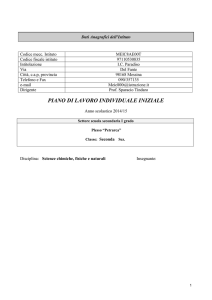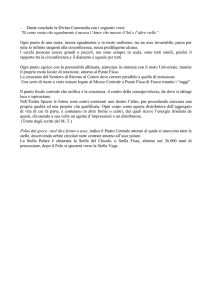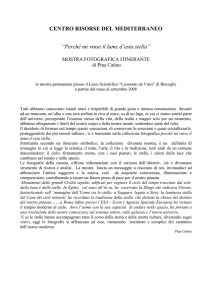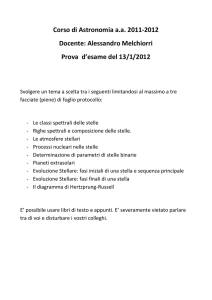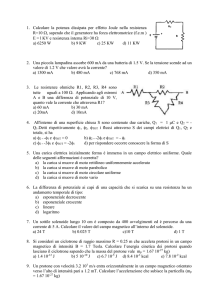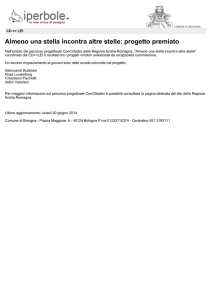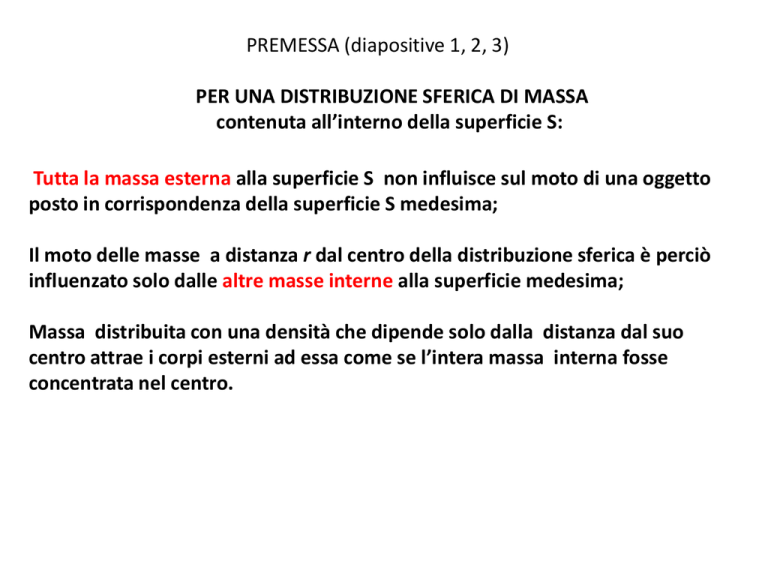
PREMESSA (diapositive 1, 2, 3)
PER UNA DISTRIBUZIONE SFERICA DI MASSA
contenuta all’interno della superficie S:
Tutta la massa esterna alla superficie S non influisce sul moto di una oggetto
posto in corrispondenza della superficie S medesima;
Il moto delle masse a distanza r dal centro della distribuzione sferica è perciò
influenzato solo dalle altre masse interne alla superficie medesima;
Massa distribuita con una densità che dipende solo dalla distanza dal suo
centro attrae i corpi esterni ad essa come se l’intera massa interna fosse
concentrata nel centro.
Il moto della stella (corpo) dipende solo dalle stelle (corpi) poste internamente
alla sfera indicata nelle figure, sia che la densità sia costante sia che la densità sia
variabile radialmente
Densità costante
r
Densità variabile con la distanza dal centro
r
M tot m
La forza risultante sulla stella NON è F mg G
e quindi, in particolare,
2
r
non vale la terza legge
di Keplero
Il moto della stella non è kepleriano, non è come il moto dei pianeti del Sistema Solare.
Il moto della stella (corpo) dipende solo dalle stelle (corpi) poste internamente
alla sfera indicata nelle figure, quindi da tutte le stelle presenti, sia che la densità sia
costante sia che la densità sia variabile radialmente. Ora tutte le stelle attraggono la
stella indicata come se esse fossero un unico corpo, posto nel centro della
distribuzione sferica, avente per massa la somma di tutte le masse.
r
r
Ora la forza sulla stella è proprio
F mg G
M tot m dove M rappresenta la massa
r 2 totale di tutte le stelle
interne alla sfera
Quando siamo al di là di tutte le masse, il moto di una stella è perciò kepleriano:
T kr
2
3
o, in termini di velocità
v
GM tot
r
The Virial Theorem
http://www.astro.cornell.edu/academics/courses/astro201/vt.htm
The virial theorem states that, for a stable, self-gravitating, spherical distribution
of equal mass objects (stars, galaxies, etc),*
the total kinetic energy of the objects is equal to minus 1/2 times the total
gravitational potential energy:
2Ecin. tot. U tot. 0
In other words, the potential energy must equal the kinetic energy, within a factor
of two**.
* dato un sistema di masse le cui interazioni reciproche siano di tipo gravitazionale e tali che i
loro moti avvengano in una porzione limitata e definita di spazio, vale a dire che il sistema
sia in una fase di equilibrio dinamico, allora….
** il fattore 2 è collegato alla dipendenza dell’interazione gravitazionale dall’inverso del
quadrato della distanza
Suppose that we have a gravitationally bound system that consists of N individual
objects (stars, galaxies, globular clusters, etc.) that have the same mass m and
some average velocity v.
The overall system has a mass Mtot = N.m and a radius Rtot.
The kinetic energy of each object is K.E.(object) = 1/2 m v2,
while the kinetic energy of the total system is
Ecin tot = K.E.(system) = 1/2 m N v2 = 1/2 Mtot v2
where v2 is the mean of the squares of v.
The gravitational potential energy of the system can be written as:
2
U tot.
2
2
tot
1 N m
1 M
G
G
2
Rtot
2 Rtot
NB: il fattore ½ nella energia potenziale può anche essere trascurato viste le
approssimazioni che facciamo. Vedi quanto affermato nell’ultima diapositiva.
We usually assume that all of the orbits travel on similar orbits that are isotropic,
that is, are not flattened in any way and have no preferential direction; we say
these are random orbits. The virial theorem then requires that the kinetic energy
equals one half the potential energy, that is:
•K.E. = - 1/2 P.E.
2
M
1
1
M tot v 2 G tot
2
4 Rtot
M tot
Rtot v 2
2
G
Therefore, we can estimate the Virial Mass of a system if we can observe:
• The true overall extent of the system Rtot
• The mean square of the velocities of the individual objects that comprise the
system
If the motions are not random/isotropic, the virial theorem still applies, but its form changes a
bit. Similarly, since our system is made up of many objects, we can gain some insight by seeing
how the orbital velocities vary with radius from the center outward.
For example, in a spiral galaxy, the dominant motion of the stars in the disk is circular rotation in
the plane of the disk. The variation in the orbital velocities with radius V(r) is called the rotation
curve (ed è la velocità da inserire nella formula per la stima della massa viriale).
Attenzione, nel Cielo come Laboratorio la formula della
massa viriale non tiene conto del fattore ½; perciò è
semplicemente:
M tot
Rtot v 2
G


